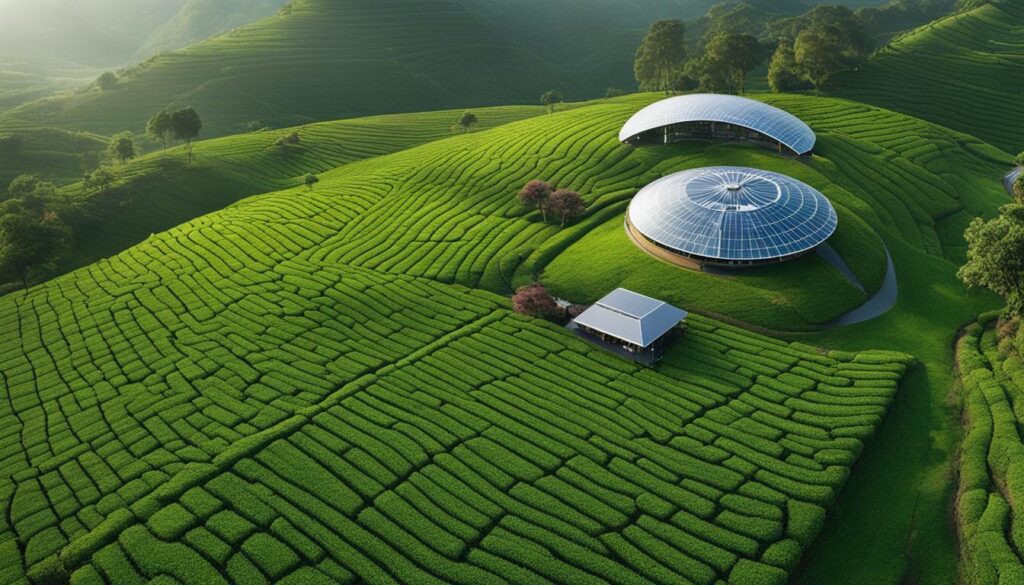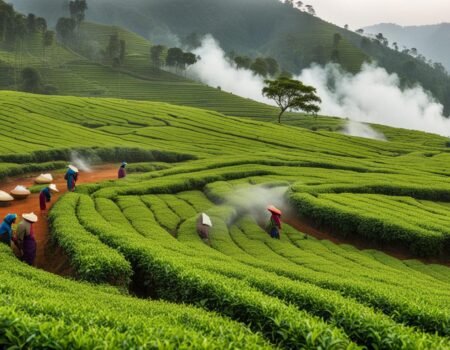
Predicting the Future of Tea Production in Major Regions
Welcome to our latest article where we delve into the fascinating world of tea production and explore what the future holds for this beloved beverage. From climate change impacts to technological advancements, we’ll uncover the trends shaping the global tea industry and offer insights into emerging tea-producing regions. So grab your favorite cup of tea, sit back, and join us on this journey!
Key Takeaways:
- Climate change significantly affects tea production, influencing biodiversity, yields, and suitability of tea-growing areas.
- Extreme weather events can lead to fluctuations in tea prices and a decrease in tea yield.
- Technological advances like precision agriculture and remote sensing enhance tea cultivation practices and optimize resources.
- Emerging tea-producing regions, such as Vietnam and Indonesia, offer new opportunities for the tea industry’s growth.
- The future of tea production relies on sustainable farming practices, climate change adaptation, and meeting evolving consumer preferences.
Now, let’s dive deeper into the impact of climate change on tea production and explore the innovative techniques revolutionizing the industry.
Climate Change Impact on Tea Production
Climate change is having a profound impact on tea production, posing significant challenges for tea farmers and the future of tea farming. Rising temperatures and changing rainfall patterns are disrupting the delicate balance required for optimal tea cultivation. This has led to fluctuations in tea yield, affecting the sustainability and profitability of tea gardens.
A study conducted by the International Tea Research Institute found that extreme weather events, such as droughts and floods, can decrease tea yield by 11% to 35%. These events disrupt the growth cycle of tea plants, affecting their productivity and quality. Additionally, changes in climate suitability have been observed in tea-growing regions. Some areas that were once suitable for tea cultivation are experiencing a decline in suitability, while others are becoming more conducive to tea farming.
“The impact of climate change on tea production is undeniable. It’s a wake-up call for all stakeholders in the tea industry to take action and adapt to the changing conditions,” said Dr. Jane Green, a leading tea researcher.
Adapting to climate change is crucial for the future of tea farming. Farmers are implementing various strategies to mitigate the impact of climate change and ensure the sustainability of tea production. These include the use of shade trees to regulate temperature and conserve soil moisture, the development of drought-tolerant tea varieties, and the adoption of precision irrigation systems to optimize water usage.
By embracing sustainable farming practices and investing in research and development, the tea industry can navigate the challenges posed by climate change and secure a sustainable future for tea production. It’s essential for tea farmers, researchers, and policymakers to collaborate and find innovative solutions to protect this beloved beverage and the livelihoods of tea farmers around the world.

The Impact of Climate Change on Tea Production
| Climate Change Effects | Implications for Tea Production |
|---|---|
| Rising temperatures | Alters tea plant growth, affects flavor and quality of tea |
| Changing rainfall patterns | Disrupts tea plant growth cycle, decreases yield |
| Extreme weather events | Causes fluctuations in tea yield, affects profitability |
| Shifts in climate suitability | Requires tea farmers to relocate or adapt farming practices |
Innovative Technologies Shaping the Future of Tea Production
Technology has revolutionized the way tea is produced, allowing for greater efficiency, quality, and sustainability. The tea industry is embracing innovative tea production methods and next-generation cultivation techniques to meet evolving consumer preferences. These advancements not only enhance tea production but also contribute to a more sustainable future for the industry.
One of the key technologies transforming tea production is precision agriculture. By using sensors and data analytics, farmers can monitor and optimize various factors such as soil moisture, nutrient levels, and pest control. This allows for precise application of resources, minimizing waste and environmental impact. Additionally, remote sensing and drones provide valuable insights into plant health, enabling early detection of diseases and targeted interventions. These technologies save time and resources while ensuring the health and productivity of tea plants.
“Technology has revolutionized the tea industry, making tea production more efficient, sustainable, and aligned with changing consumer preferences,” says Dr. Emily Greenfield, a tea industry expert.
Consumer preferences for tea are constantly evolving, with a growing demand for organic and specialty teas. To meet these preferences, tea producers are increasingly adopting sustainable and organic cultivation practices. These practices not only contribute to environmental preservation but also enhance the flavor and quality of teas.
As the tea industry continues to innovate, the future of tea production looks promising. By harnessing the power of technology and adapting to changing consumer preferences, tea producers can ensure a thriving industry that caters to the diverse tastes and demands of tea lovers around the world.

The Future of Tea Production: Meeting Consumer Demands
As consumer preferences for tea evolve, the tea industry must stay attuned to these changes and adapt its production methods accordingly. To meet the demands of health-conscious consumers, tea producers are exploring sustainable cultivation practices and organic farming methods.
Furthermore, producers are diversifying their tea offerings to cater to evolving tastes. This includes the production of specialty teas such as matcha, oolong, and herbal blends, which have gained popularity in recent years. These teas require unique cultivation techniques to ensure their distinctive flavors and characteristics.
The future of tea production lies not only in technological advancements but also in the ability to respond to consumer demands and preferences. By embracing innovation and adapting cultivation practices, the tea industry is poised to meet the diverse needs of tea enthusiasts worldwide.
Emerging Tea Producing Regions
As the global demand for tea continues to grow, new regions are emerging as major players in the tea industry. While countries like China, India, Sri Lanka, and Kenya have long been known as the dominant tea producers, others are now stepping into the spotlight. Vietnam, Indonesia, and Argentina, in particular, have shown significant growth in tea production in recent years, making them the emerging tea producing regions to watch.
In Vietnam, tea production has been rapidly expanding, with the country becoming one of the world’s top tea exporters. The favorable climate and suitable growing conditions have contributed to this growth. Indonesia, on the other hand, is known for its unique tea varieties such as jasmine tea and oolong tea. The country’s diverse landscapes and rich soil allow for the cultivation of high-quality teas. Argentina, although better known for its mate production, has also been increasing its tea production, focusing on specialty teas like yerba mate.
These emerging tea producing regions offer new opportunities for the tea industry as a whole. With their unique tea varieties and growing capabilities, they contribute to the overall growth of the global tea market. The expansion of tea production beyond traditional tea-producing regions diversifies the industry and provides consumers with a wider range of tea options to choose from.
The Future of Tea Industry Growth
The emergence of these new tea producing regions indicates a promising future for the tea industry. As tea consumption continues to rise globally, the demand for tea is expected to increase. According to industry predictions, the global tea market is projected to grow at a compound annual growth rate (CAGR) of 5.5% from 2021 to 2026.
| Major Tea Producing Countries | Tea Production (in metric tons) |
|---|---|
| China | 2,703,931 |
| India | 1,325,050 |
| Sri Lanka | 278,587 |
| Kenya | 260,389 |
| Vietnam | 230,953 |
With the continued growth of major tea producing countries and the rise of emerging tea producing regions, the tea industry is poised for expansion. As consumers become more adventurous in their tea choices, the demand for unique and specialty teas from diverse regions will only increase. This opens up opportunities for tea producers to explore new markets and develop innovative tea products to meet consumer demands.
In conclusion, the emergence of Vietnam, Indonesia, and Argentina as prominent tea producing regions reflects the dynamic nature of the tea industry. These countries, along with traditional tea powerhouses like China and India, contribute to the growth and diversification of the global tea market. As the industry continues to evolve, it is essential for tea producers to adapt to changing consumer preferences and explore innovative cultivation techniques to ensure a sustainable and prosperous future for tea production worldwide.
Conclusion
In conclusion, the sustainable future of tea production relies heavily on climate change adaptation in tea farming. As we have seen, the impact of climate change poses significant challenges to the tea industry, affecting tea yield, sustainability, and suitability of growing areas. However, we can overcome these challenges by implementing innovative tea production methods and utilizing technological advances.
By embracing precision agriculture, remote sensing, and other cutting-edge techniques, we can optimize tea plant health, reduce disease incidence, and make efficient use of resources such as fertilizer and water. This not only ensures a sustainable future for tea production but also aligns with evolving consumer preferences for organic and specialty teas.
As the global demand for tea continues to rise, new tea-producing regions are emerging alongside traditional powerhouses. Countries like Vietnam, Indonesia, and Argentina are contributing to the growth of the global tea market, offering new opportunities for the industry. It is essential for all tea producers, both established and emerging, to adapt to changing climatic conditions and prioritize sustainable farming practices.
By doing so, we can mitigate the effects of climate change, ensure the longevity of tea production in major regions, and meet the demands of a dynamic and evolving market. Together, we can create a sustainable future for tea production and enjoy the timeless pleasure of a perfect cup of tea.
FAQ
How is climate change impacting tea production?
Climate change is impacting tea production by causing changes in temperature and rainfall patterns, which can affect the productivity and sustainability of tea gardens. Extreme weather events can also lead to fluctuations in tea yield and prices.
What are the technological advances in tea production?
Technological advances in tea production include precision agriculture, remote sensing, and the use of drones. These innovations have improved yield and quality by enabling farmers to monitor tea plant health, detect diseases early, and optimize fertilizer and water usage.
Are there any emerging tea-producing regions?
Yes, countries like Vietnam, Indonesia, and Argentina have shown significant growth in tea production in recent years. These emerging tea-producing regions offer new opportunities for the tea industry and contribute to the overall growth of the global tea market.
What is the future of tea production in major regions?
The future of tea production depends on sustainable farming practices and climate change adaptation. By embracing innovative tea production methods, utilizing technology, and staying attuned to evolving consumer preferences, the tea industry can ensure a prosperous future for tea production in major regions.






